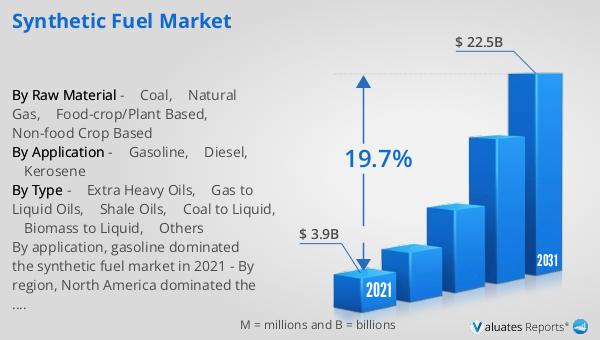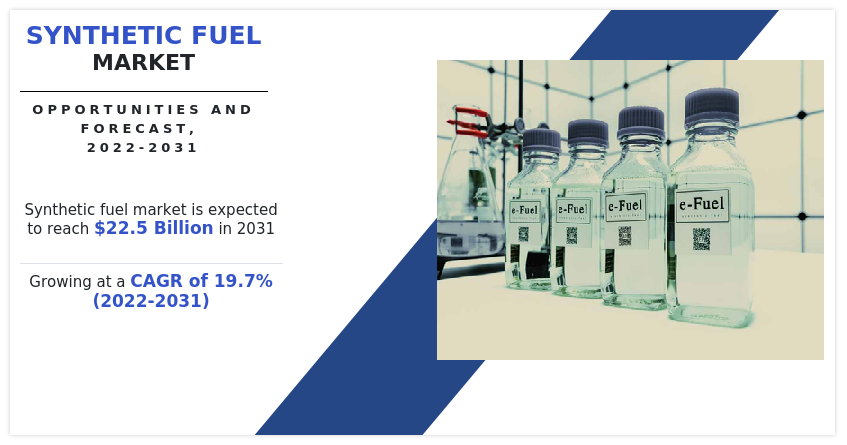LIST OF TABLES
TABLE 01. GLOBAL SYNTHETIC FUEL MARKET, BY RAW MATERIAL, 2021-2031 ($MILLION)
TABLE 02. SYNTHETIC FUEL MARKET FOR COAL, BY REGION, 2021-2031 ($MILLION)
TABLE 03. SYNTHETIC FUEL MARKET FOR NATURAL GAS, BY REGION, 2021-2031 ($MILLION)
TABLE 04. SYNTHETIC FUEL MARKET FOR FOOD-CROP/PLANT BASED, BY REGION, 2021-2031 ($MILLION)
TABLE 05. SYNTHETIC FUEL MARKET FOR NON-FOOD CROP BASED, BY REGION, 2021-2031 ($MILLION)
TABLE 06. GLOBAL SYNTHETIC FUEL MARKET, BY TYPE, 2021-2031 ($MILLION)
TABLE 07. SYNTHETIC FUEL MARKET FOR EXTRA HEAVY OILS, BY REGION, 2021-2031 ($MILLION)
TABLE 08. SYNTHETIC FUEL MARKET FOR GAS TO LIQUID OILS, BY REGION, 2021-2031 ($MILLION)
TABLE 09. SYNTHETIC FUEL MARKET FOR SHALE OILS, BY REGION, 2021-2031 ($MILLION)
TABLE 10. SYNTHETIC FUEL MARKET FOR COAL TO LIQUID, BY REGION, 2021-2031 ($MILLION)
TABLE 11. SYNTHETIC FUEL MARKET FOR BIOMASS TO LIQUID, BY REGION, 2021-2031 ($MILLION)
TABLE 12. SYNTHETIC FUEL MARKET FOR OTHERS, BY REGION, 2021-2031 ($MILLION)
TABLE 13. GLOBAL SYNTHETIC FUEL MARKET, BY APPLICATION, 2021-2031 ($MILLION)
TABLE 14. SYNTHETIC FUEL MARKET FOR GASOLINE, BY REGION, 2021-2031 ($MILLION)
TABLE 15. SYNTHETIC FUEL MARKET FOR DIESEL, BY REGION, 2021-2031 ($MILLION)
TABLE 16. SYNTHETIC FUEL MARKET FOR KEROSENE, BY REGION, 2021-2031 ($MILLION)
TABLE 17. SYNTHETIC FUEL MARKET, BY REGION, 2021-2031 ($MILLION)
TABLE 18. NORTH AMERICA SYNTHETIC FUEL MARKET, BY RAW MATERIAL, 2021-2031 ($MILLION)
TABLE 19. NORTH AMERICA SYNTHETIC FUEL MARKET, BY TYPE, 2021-2031 ($MILLION)
TABLE 20. NORTH AMERICA SYNTHETIC FUEL MARKET, BY APPLICATION, 2021-2031 ($MILLION)
TABLE 21. NORTH AMERICA SYNTHETIC FUEL MARKET, BY COUNTRY, 2021-2031 ($MILLION)
TABLE 22. U.S. SYNTHETIC FUEL MARKET, BY RAW MATERIAL, 2021-2031 ($MILLION)
TABLE 23. U.S. SYNTHETIC FUEL MARKET, BY TYPE, 2021-2031 ($MILLION)
TABLE 24. U.S. SYNTHETIC FUEL MARKET, BY APPLICATION, 2021-2031 ($MILLION)
TABLE 25. CANADA SYNTHETIC FUEL MARKET, BY RAW MATERIAL, 2021-2031 ($MILLION)
TABLE 26. CANADA SYNTHETIC FUEL MARKET, BY TYPE, 2021-2031 ($MILLION)
TABLE 27. CANADA SYNTHETIC FUEL MARKET, BY APPLICATION, 2021-2031 ($MILLION)
TABLE 28. MEXICO SYNTHETIC FUEL MARKET, BY RAW MATERIAL, 2021-2031 ($MILLION)
TABLE 29. MEXICO SYNTHETIC FUEL MARKET, BY TYPE, 2021-2031 ($MILLION)
TABLE 30. MEXICO SYNTHETIC FUEL MARKET, BY APPLICATION, 2021-2031 ($MILLION)
TABLE 31. EUROPE SYNTHETIC FUEL MARKET, BY RAW MATERIAL, 2021-2031 ($MILLION)
TABLE 32. EUROPE SYNTHETIC FUEL MARKET, BY TYPE, 2021-2031 ($MILLION)
TABLE 33. EUROPE SYNTHETIC FUEL MARKET, BY APPLICATION, 2021-2031 ($MILLION)
TABLE 34. EUROPE SYNTHETIC FUEL MARKET, BY COUNTRY, 2021-2031 ($MILLION)
TABLE 35. GERMANY SYNTHETIC FUEL MARKET, BY RAW MATERIAL, 2021-2031 ($MILLION)
TABLE 36. GERMANY SYNTHETIC FUEL MARKET, BY TYPE, 2021-2031 ($MILLION)
TABLE 37. GERMANY SYNTHETIC FUEL MARKET, BY APPLICATION, 2021-2031 ($MILLION)
TABLE 38. UK SYNTHETIC FUEL MARKET, BY RAW MATERIAL, 2021-2031 ($MILLION)
TABLE 39. UK SYNTHETIC FUEL MARKET, BY TYPE, 2021-2031 ($MILLION)
TABLE 40. UK SYNTHETIC FUEL MARKET, BY APPLICATION, 2021-2031 ($MILLION)
TABLE 41. FRANCE SYNTHETIC FUEL MARKET, BY RAW MATERIAL, 2021-2031 ($MILLION)
TABLE 42. FRANCE SYNTHETIC FUEL MARKET, BY TYPE, 2021-2031 ($MILLION)
TABLE 43. FRANCE SYNTHETIC FUEL MARKET, BY APPLICATION, 2021-2031 ($MILLION)
TABLE 44. ITALY SYNTHETIC FUEL MARKET, BY RAW MATERIAL, 2021-2031 ($MILLION)
TABLE 45. ITALY SYNTHETIC FUEL MARKET, BY TYPE, 2021-2031 ($MILLION)
TABLE 46. ITALY SYNTHETIC FUEL MARKET, BY APPLICATION, 2021-2031 ($MILLION)
TABLE 47. SPAIN SYNTHETIC FUEL MARKET, BY RAW MATERIAL, 2021-2031 ($MILLION)
TABLE 48. SPAIN SYNTHETIC FUEL MARKET, BY TYPE, 2021-2031 ($MILLION)
TABLE 49. SPAIN SYNTHETIC FUEL MARKET, BY APPLICATION, 2021-2031 ($MILLION)
TABLE 50. REST OF EUROPE SYNTHETIC FUEL MARKET, BY RAW MATERIAL, 2021-2031 ($MILLION)
TABLE 51. REST OF EUROPE SYNTHETIC FUEL MARKET, BY TYPE, 2021-2031 ($MILLION)
TABLE 52. REST OF EUROPE SYNTHETIC FUEL MARKET, BY APPLICATION, 2021-2031 ($MILLION)
TABLE 53. ASIA-PACIFIC SYNTHETIC FUEL MARKET, BY RAW MATERIAL, 2021-2031 ($MILLION)
TABLE 54. ASIA-PACIFIC SYNTHETIC FUEL MARKET, BY TYPE, 2021-2031 ($MILLION)
TABLE 55. ASIA-PACIFIC SYNTHETIC FUEL MARKET, BY APPLICATION, 2021-2031 ($MILLION)
TABLE 56. ASIA-PACIFIC SYNTHETIC FUEL MARKET, BY COUNTRY, 2021-2031 ($MILLION)
TABLE 57. CHINA SYNTHETIC FUEL MARKET, BY RAW MATERIAL, 2021-2031 ($MILLION)
TABLE 58. CHINA SYNTHETIC FUEL MARKET, BY TYPE, 2021-2031 ($MILLION)
TABLE 59. CHINA SYNTHETIC FUEL MARKET, BY APPLICATION, 2021-2031 ($MILLION)
TABLE 60. JAPAN SYNTHETIC FUEL MARKET, BY RAW MATERIAL, 2021-2031 ($MILLION)
TABLE 61. JAPAN SYNTHETIC FUEL MARKET, BY TYPE, 2021-2031 ($MILLION)
TABLE 62. JAPAN SYNTHETIC FUEL MARKET, BY APPLICATION, 2021-2031 ($MILLION)
TABLE 63. INDIA SYNTHETIC FUEL MARKET, BY RAW MATERIAL, 2021-2031 ($MILLION)
TABLE 64. INDIA SYNTHETIC FUEL MARKET, BY TYPE, 2021-2031 ($MILLION)
TABLE 65. INDIA SYNTHETIC FUEL MARKET, BY APPLICATION, 2021-2031 ($MILLION)
TABLE 66. SOUTH KOREA SYNTHETIC FUEL MARKET, BY RAW MATERIAL, 2021-2031 ($MILLION)
TABLE 67. SOUTH KOREA SYNTHETIC FUEL MARKET, BY TYPE, 2021-2031 ($MILLION)
TABLE 68. SOUTH KOREA SYNTHETIC FUEL MARKET, BY APPLICATION, 2021-2031 ($MILLION)
TABLE 69. AUSTRALIA SYNTHETIC FUEL MARKET, BY RAW MATERIAL, 2021-2031 ($MILLION)
TABLE 70. AUSTRALIA SYNTHETIC FUEL MARKET, BY TYPE, 2021-2031 ($MILLION)
TABLE 71. AUSTRALIA SYNTHETIC FUEL MARKET, BY APPLICATION, 2021-2031 ($MILLION)
TABLE 72. REST OF ASIA-PACIFIC SYNTHETIC FUEL MARKET, BY RAW MATERIAL, 2021-2031 ($MILLION)
TABLE 73. REST OF ASIA-PACIFIC SYNTHETIC FUEL MARKET, BY TYPE, 2021-2031 ($MILLION)
TABLE 74. REST OF ASIA-PACIFIC SYNTHETIC FUEL MARKET, BY APPLICATION, 2021-2031 ($MILLION)
TABLE 75. LAMEA SYNTHETIC FUEL MARKET, BY RAW MATERIAL, 2021-2031 ($MILLION)
TABLE 76. LAMEA SYNTHETIC FUEL MARKET, BY TYPE, 2021-2031 ($MILLION)
TABLE 77. LAMEA SYNTHETIC FUEL MARKET, BY APPLICATION, 2021-2031 ($MILLION)
TABLE 78. LAMEA SYNTHETIC FUEL MARKET, BY COUNTRY, 2021-2031 ($MILLION)
TABLE 79. BRAZIL SYNTHETIC FUEL MARKET, BY RAW MATERIAL, 2021-2031 ($MILLION)
TABLE 80. BRAZIL SYNTHETIC FUEL MARKET, BY TYPE, 2021-2031 ($MILLION)
TABLE 81. BRAZIL SYNTHETIC FUEL MARKET, BY APPLICATION, 2021-2031 ($MILLION)
TABLE 82. SOUTH AFRICA, SYNTHETIC FUEL MARKET, BY RAW MATERIAL, 2021-2031 ($MILLION)
TABLE 83. SOUTH AFRICA, SYNTHETIC FUEL MARKET, BY TYPE, 2021-2031 ($MILLION)
TABLE 84. SOUTH AFRICA, SYNTHETIC FUEL MARKET, BY APPLICATION, 2021-2031 ($MILLION)
TABLE 85. SAUDI ARABIA SYNTHETIC FUEL MARKET, BY RAW MATERIAL, 2021-2031 ($MILLION)
TABLE 86. SAUDI ARABIA SYNTHETIC FUEL MARKET, BY TYPE, 2021-2031 ($MILLION)
TABLE 87. SAUDI ARABIA SYNTHETIC FUEL MARKET, BY APPLICATION, 2021-2031 ($MILLION)
TABLE 88. REST OF LAMEA SYNTHETIC FUEL MARKET, BY RAW MATERIAL, 2021-2031 ($MILLION)
TABLE 89. REST OF LAMEA SYNTHETIC FUEL MARKET, BY TYPE, 2021-2031 ($MILLION)
TABLE 90. REST OF LAMEA SYNTHETIC FUEL MARKET, BY APPLICATION, 2021-2031 ($MILLION)
TABLE 91. SHELL PLC.: KEY EXECUTIVES
TABLE 92. SHELL PLC.: COMPANY SNAPSHOT
TABLE 93. SHELL PLC.: PRODUCT SEGMENTS
TABLE 94. SHELL PLC.: PRODUCT PORTFOLIO
TABLE 95. BOSCH LTD: KEY EXECUTIVES
TABLE 96. BOSCH LTD: COMPANY SNAPSHOT
TABLE 97. BOSCH LTD: PRODUCT SEGMENTS
TABLE 98. BOSCH LTD: PRODUCT PORTFOLIO
TABLE 99. INDIAN OIL CORPORATION LTD: KEY EXECUTIVES
TABLE 100. INDIAN OIL CORPORATION LTD: COMPANY SNAPSHOT
TABLE 101. INDIAN OIL CORPORATION LTD: PRODUCT SEGMENTS
TABLE 102. INDIAN OIL CORPORATION LTD: PRODUCT PORTFOLIO
TABLE 103. RELIANCE INDUSTRIES LTD: KEY EXECUTIVES
TABLE 104. RELIANCE INDUSTRIES LTD: COMPANY SNAPSHOT
TABLE 105. RELIANCE INDUSTRIES LTD: PRODUCT SEGMENTS
TABLE 106. RELIANCE INDUSTRIES LTD: PRODUCT PORTFOLIO
TABLE 107. SASOL LIMITED: KEY EXECUTIVES
TABLE 108. SASOL LIMITED: COMPANY SNAPSHOT
TABLE 109. SASOL LIMITED: PRODUCT SEGMENTS
TABLE 110. SASOL LIMITED: PRODUCT PORTFOLIO
TABLE 111. L'AIR LIQUIDE S.A.: KEY EXECUTIVES
TABLE 112. L'AIR LIQUIDE S.A.: COMPANY SNAPSHOT
TABLE 113. L'AIR LIQUIDE S.A.: PRODUCT SEGMENTS
TABLE 114. L'AIR LIQUIDE S.A.: PRODUCT PORTFOLIO
TABLE 115. PHILLIPS 66 COMPANY: KEY EXECUTIVES
TABLE 116. PHILLIPS 66 COMPANY: COMPANY SNAPSHOT
TABLE 117. PHILLIPS 66 COMPANY: PRODUCT SEGMENTS
TABLE 118. PHILLIPS 66 COMPANY: PRODUCT PORTFOLIO
TABLE 119. PETROCHINA COMPANY LIMITED: KEY EXECUTIVES
TABLE 120. PETROCHINA COMPANY LIMITED: COMPANY SNAPSHOT
TABLE 121. PETROCHINA COMPANY LIMITED: PRODUCT SEGMENTS
TABLE 122. PETROCHINA COMPANY LIMITED: PRODUCT PORTFOLIO
TABLE 123. EXXON MOBIL CORPORATION: KEY EXECUTIVES
TABLE 124. EXXON MOBIL CORPORATION: COMPANY SNAPSHOT
TABLE 125. EXXON MOBIL CORPORATION: SERVICE SEGMENTS
TABLE 126. EXXON MOBIL CORPORATION: PRODUCT PORTFOLIO
TABLE 127. SYNHELION SA: KEY EXECUTIVES
TABLE 128. SYNHELION SA: COMPANY SNAPSHOT
TABLE 129. SYNHELION SA: PRODUCT SEGMENTS
TABLE 130. SYNHELION SA: PRODUCT PORTFOLIO LIST OF FIGURES
FIGURE 01. SYNTHETIC FUEL MARKET, 2021-2031
FIGURE 02. SEGMENTATION OF SYNTHETIC FUEL MARKET, 2021-2031
FIGURE 03. TOP INVESTMENT POCKETS IN SYNTHETIC FUEL MARKET (2022-2031)
FIGURE 04. LOW BARGAINING POWER OF SUPPLIERS
FIGURE 05. LOW BARGAINING POWER OF BUYERS
FIGURE 06. LOW THREAT OF SUBSTITUTES
FIGURE 07. LOW THREAT OF NEW ENTRANTS
FIGURE 08. LOW INTENSITY OF RIVALRY
FIGURE 09. DRIVERS, RESTRAINTS AND OPPORTUNITIES: GLOBALSYNTHETIC FUEL MARKET
FIGURE 10. PATENT ANALYSIS BY COMPANY
FIGURE 11. PATENT ANALYSIS BY COUNTRY
FIGURE 12. SYNTHETIC FUEL MARKET, BY RAW MATERIAL, 2021(%)
FIGURE 13. COMPARATIVE SHARE ANALYSIS OF SYNTHETIC FUEL MARKET FOR COAL, BY COUNTRY 2021 AND 2031(%)
FIGURE 14. COMPARATIVE SHARE ANALYSIS OF SYNTHETIC FUEL MARKET FOR NATURAL GAS, BY COUNTRY 2021 AND 2031(%)
FIGURE 15. COMPARATIVE SHARE ANALYSIS OF SYNTHETIC FUEL MARKET FOR FOOD-CROP/PLANT BASED, BY COUNTRY 2021 AND 2031(%)
FIGURE 16. COMPARATIVE SHARE ANALYSIS OF SYNTHETIC FUEL MARKET FOR NON-FOOD CROP BASED, BY COUNTRY 2021 AND 2031(%)
FIGURE 17. SYNTHETIC FUEL MARKET, BY TYPE, 2021(%)
FIGURE 18. COMPARATIVE SHARE ANALYSIS OF SYNTHETIC FUEL MARKET FOR EXTRA HEAVY OILS, BY COUNTRY 2021 AND 2031(%)
FIGURE 19. COMPARATIVE SHARE ANALYSIS OF SYNTHETIC FUEL MARKET FOR GAS TO LIQUID OILS, BY COUNTRY 2021 AND 2031(%)
FIGURE 20. COMPARATIVE SHARE ANALYSIS OF SYNTHETIC FUEL MARKET FOR SHALE OILS, BY COUNTRY 2021 AND 2031(%)
FIGURE 21. COMPARATIVE SHARE ANALYSIS OF SYNTHETIC FUEL MARKET FOR COAL TO LIQUID, BY COUNTRY 2021 AND 2031(%)
FIGURE 22. COMPARATIVE SHARE ANALYSIS OF SYNTHETIC FUEL MARKET FOR BIOMASS TO LIQUID, BY COUNTRY 2021 AND 2031(%)
FIGURE 23. COMPARATIVE SHARE ANALYSIS OF SYNTHETIC FUEL MARKET FOR OTHERS, BY COUNTRY 2021 AND 2031(%)
FIGURE 24. SYNTHETIC FUEL MARKET, BY APPLICATION, 2021(%)
FIGURE 25. COMPARATIVE SHARE ANALYSIS OF SYNTHETIC FUEL MARKET FOR GASOLINE, BY COUNTRY 2021 AND 2031(%)
FIGURE 26. COMPARATIVE SHARE ANALYSIS OF SYNTHETIC FUEL MARKET FOR DIESEL, BY COUNTRY 2021 AND 2031(%)
FIGURE 27. COMPARATIVE SHARE ANALYSIS OF SYNTHETIC FUEL MARKET FOR KEROSENE, BY COUNTRY 2021 AND 2031(%)
FIGURE 28. SYNTHETIC FUEL MARKET BY REGION, 2021
FIGURE 29. U.S. SYNTHETIC FUEL MARKET, 2021-2031 ($MILLION)
FIGURE 30. CANADA SYNTHETIC FUEL MARKET, 2021-2031 ($MILLION)
FIGURE 31. MEXICO SYNTHETIC FUEL MARKET, 2021-2031 ($MILLION)
FIGURE 32. GERMANY SYNTHETIC FUEL MARKET, 2021-2031 ($MILLION)
FIGURE 33. UK SYNTHETIC FUEL MARKET, 2021-2031 ($MILLION)
FIGURE 34. FRANCE SYNTHETIC FUEL MARKET, 2021-2031 ($MILLION)
FIGURE 35. ITALY SYNTHETIC FUEL MARKET, 2021-2031 ($MILLION)
FIGURE 36. SPAIN SYNTHETIC FUEL MARKET, 2021-2031 ($MILLION)
FIGURE 37. REST OF EUROPE SYNTHETIC FUEL MARKET, 2021-2031 ($MILLION)
FIGURE 38. CHINA SYNTHETIC FUEL MARKET, 2021-2031 ($MILLION)
FIGURE 39. JAPAN SYNTHETIC FUEL MARKET, 2021-2031 ($MILLION)
FIGURE 40. INDIA SYNTHETIC FUEL MARKET, 2021-2031 ($MILLION)
FIGURE 41. SOUTH KOREA SYNTHETIC FUEL MARKET, 2021-2031 ($MILLION)
FIGURE 42. AUSTRALIA SYNTHETIC FUEL MARKET, 2021-2031 ($MILLION)
FIGURE 43. REST OF ASIA-PACIFIC SYNTHETIC FUEL MARKET, 2021-2031 ($MILLION)
FIGURE 44. BRAZIL SYNTHETIC FUEL MARKET, 2021-2031 ($MILLION)
FIGURE 45. SOUTH AFRICA, SYNTHETIC FUEL MARKET, 2021-2031 ($MILLION)
FIGURE 46. SAUDI ARABIA SYNTHETIC FUEL MARKET, 2021-2031 ($MILLION)
FIGURE 47. REST OF LAMEA SYNTHETIC FUEL MARKET, 2021-2031 ($MILLION)
FIGURE 48. TOP WINNING STRATEGIES, BY YEAR
FIGURE 49. TOP WINNING STRATEGIES, BY DEVELOPMENT
FIGURE 50. TOP WINNING STRATEGIES, BY COMPANY
FIGURE 51. PRODUCT MAPPING OF TOP 10 PLAYERS
FIGURE 52. COMPETITIVE DASHBOARD
FIGURE 53. COMPETITIVE HEATMAP: SYNTHETIC FUEL MARKET
FIGURE 54. TOP PLAYER POSITIONING, 2021
FIGURE 55. SHELL PLC.: NET REVENUE, 2020-2022 ($MILLION)
FIGURE 56. SHELL PLC.: REVENUE SHARE BY SEGMENT, 2022 (%)
FIGURE 57. BOSCH LTD: NET REVENUE, 2019-2021 ($MILLION)
FIGURE 58. BOSCH LTD: REVENUE SHARE BY REGION, 2021 (%)
FIGURE 59. INDIAN OIL CORPORATION LTD: NET REVENUE, 2020-2022 ($MILLION)
FIGURE 60. INDIAN OIL CORPORATION LTD: REVENUE SHARE BY SEGMENT, 2022 (%)
FIGURE 61. RELIANCE INDUSTRIES LTD: NET SALES, 2019-2021 ($MILLION)
FIGURE 62. RELIANCE INDUSTRIES LTD: REVENUE SHARE BY SEGMENT, 2021 (%)
FIGURE 63. RELIANCE INDUSTRIES LTD: REVENUE SHARE BY REGION, 2021 (%)
FIGURE 64. SASOL LIMITED: NET REVENUE, 2020-2022 ($MILLION)
FIGURE 65. SASOL LIMITED: REVENUE SHARE BY SEGMENT, 2022 (%)
FIGURE 66. SASOL LIMITED: REVENUE SHARE BY SEGMENT, 2022 (%)
FIGURE 67. SASOL LIMITED: REVENUE SHARE BY SEGMENT, 2022 (%)
FIGURE 68. L'AIR LIQUIDE S.A.: NET REVENUE, 2020-2022 ($MILLION)
FIGURE 69. L'AIR LIQUIDE S.A.: REVENUE SHARE BY SEGMENT, 2022 (%)
FIGURE 70. L'AIR LIQUIDE S.A.: REVENUE SHARE BY REGION, 2022 (%)
FIGURE 71. PHILLIPS 66 COMPANY: NET SALES, 2018-2020 ($MILLION)
FIGURE 72. PHILLIPS 66 COMPANY: RESEARCH & DEVELOPMENT EXPENDITURE, 2018-2020 ($MILLION)
FIGURE 73. PHILLIPS 66 COMPANY: REVENUE SHARE BY SEGMENT, 2020 (%)
FIGURE 74. PETROCHINA COMPANY LIMITED: NET REVENUE, 2019-2021 ($MILLION)
FIGURE 75. PETROCHINA COMPANY LIMITED: REVENUE SHARE BY SEGMENT, 2021 (%)
FIGURE 76. EXXON MOBIL CORPORATION: NET SALES, 2020-2022 ($MILLION)
FIGURE 77. EXXON MOBIL CORPORATION: REVENUE SHARE BY SEGMENT, 2022 (%)
FIGURE 78. EXXON MOBIL CORPORATION: REVENUE SHARE BY REGION, 2022 (%



